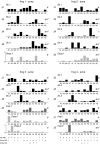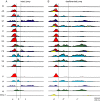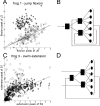Central and sensory contributions to the activation and organization of muscle synergies during natural motor behaviors
- PMID: 16000633
- PMCID: PMC6725265
- DOI: 10.1523/JNEUROSCI.4904-04.2005
Central and sensory contributions to the activation and organization of muscle synergies during natural motor behaviors
Abstract
Previous studies have suggested that the motor system may simplify control by combining a small number of muscle synergies represented as activation profiles across a set of muscles. The role of sensory feedback in the activation and organization of synergies has remained an open question. Here, we assess to what extent the motor system relies on centrally organized synergies activated by spinal and/or supraspinal commands to generate motor outputs by analyzing electromyographic (EMG) signals collected from 13 hindlimb muscles of the bullfrog during swimming and jumping, before and after deafferentation. We first established that, for both behaviors, the intact and deafferented data sets possess low and similar dimensionalities. Subsequently, we used a novel reformulation of the non-negative matrix factorization algorithm to simultaneously search for synergies shared by, and synergies specific to, the intact and deafferented data sets. Most muscle synergies were identified as shared synergies, suggesting that EMGs of locomotor behaviors are generated primarily by centrally organized synergies. Both the amplitude and temporal patterns of the activation coefficients of most shared synergies, however, were altered by deafferentation, suggesting that sensory inflow modulates activation of those centrally organized synergies. For most synergies, effects of deafferentation on the activation coefficients were not consistent across frogs, indicating substantial interanimal variability of feedback actions. We speculate that sensory feedback might adapt recruitment of muscle synergies to behavioral constraints, and the few synergies specific to the intact or deafferented states might represent afferent-specific modules or feedback reorganization of spinal neuronal networks.
Figures










References
-
- Bates DM, Watts DG (1988) Nonlinear regression analysis and its applications. New York: Wiley.
-
- Bell AJ, Sejnowski TJ (1995) An information-maximisation approach to blind source separation and blind deconvolution. Neural Comput 7: 1129-1159. - PubMed
-
- Bernstein N (1967) The co-ordination and regulation of movements. Oxford: Pergamon.
-
- Bizzi E, Mussa-Ivaldi FA, Giszter S (1991) Computations underlying the execution of movement: a biological perspective. Science 253: 287-291. - PubMed
-
- Brown TG (1911) The intrinsic factors in the act of progression in the mammal. Proc R Soc Lond B Biol Sci 84: 308-319.
Publication types
MeSH terms
Grants and funding
LinkOut - more resources
Full Text Sources
Medical
